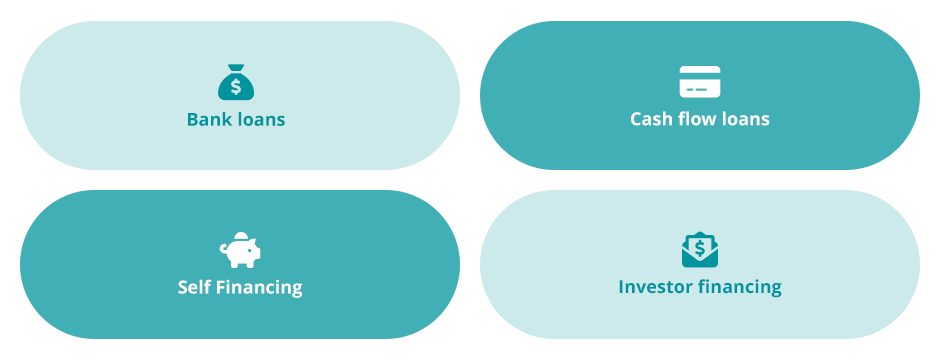TABLE OF CONTENTS
Small businesses can be an expensive and onerous proposition, often requiring small business financing to get them off the ground. You’ll almost always have to produce a thick wad of working capital to start or continue growing your business.
There are several types of small business finance options to unpack before deciding which one is best for your situation or stage of your business growth.
What are your business loan possibilities and how do they measure up in the small business finance guide below?

Bank loans
Of course, the most obvious of all the small business financing options is bank financing. Bank loans are perhaps best deployed at the beginning stages of your small business.
Small business financing through a bank loan has the added benefit of ‘detouring’ all other lender options. If you have a solid idea, a small business plan in place, possibly some collateral, equity or an asset for securing the loan, then you’re on your way to a fruitful conversation with a loan officer. As always, shop around for favourable interest rates and lending conditions.
Bank loans for small businesses have the advantages of:
- accessibility and convenience
- no profit sharing
- complete control.
However, be aware of:
- a lengthy and onerous approval process
- exhaustive prerequisites
- losing your secured collateral.
Cash flow loans
Another great choice is cash flow loans for small business. A typically short term, cash flow assisting loan is unsecured and generally of an easy and immediate nature.
Your assets will not be at risk and your approval time will be dramatically faster than banks. It’s not designed to grow your business, as you might use a business loan for that sort of finance.
Importantly, it’s not for unhealthy businesses desperately seeking to stay afloat.
It is for reasonably healthy businesses that are a victim of timing or temporary under funding and don’t require a particularly large loan amount. Cashflow loans are often compared to credit cards in terms of their short-term lending nature.
What are some common circumstances you could find yourself in that would necessitate a cash flow loan?
- Those who need funds fast but have guaranteed cash coming soon.
- Those buying bulk stock at discount prices.
- Meeting a rising business demand with new equipment (new coffee machines for a busy cafe or new lawnmowers for growing gardening business).
- Temporary staff for a big event or busy period (event companies, special holidays, and surge periods).
- Market expansion – maybe you need financing for a new store in a high demand area or a new fleet of trucks for a booming interstate trucking company.
If you find yourself in any of the above scenarios, consider forgoing the big four banks and use the fit for purpose, snappy and hassle free cash flow loans available here.
Self Financing
“Every time you borrow money, you’re robbing your future self,” Nathan W. Morris
I’m pretty sure you can figure this one out – you simply finance your own business from your own savings account and be without the entanglements of nosy outside investors.
But you’ll have to manage without their investment capital and equity.
Financing your small business yourself relies on extremely minimal borrowing (to the point of insignificance), but it comes with complete control over the business.
In a nutshell, this type of finance comes down to control and a lean, savvy ethic. You’ll be forced into frugal, canny business decisions by playing with your own limited coin (not other people’s dollars) and your control over the business will be absolute.
Self-financing is often favoured because it’s a lean model with the founder in complete control. If you’re a control freak, self-motivated and have a cracking idea (on top of a healthy savings account) look no further than this small business financing option.
Investor financing
“When money realises that it is in good hands, it wants to stay and multiply in those hands,” Idowu Koyenikan
This type of finance is where angel investors, venture capitalists and outside shareholders foot a lot of the bill for your start-up.
You get more capital from investment funding, but the trade-off is that you’ll forfeit sole oversight, as your investors or lenders will want a say in the business. After all, it’s their money and they want to see a return on investment.
This really amounts to having a business idea that exceeds your current savings and/or experience level. If you have a grand idea, a fully formed business model and confidence it will be a booming small business, attracting investors is a fantastic way to drive a project bigger than your boots.
An extra benefit is the wealth of knowledge and experience you’ll gain by partnering with investors as a small business finance option. They’ll also be very motivated to see their investment bloom, so growth may come a lot easier.
With all these types of funding for small businesses in mind, be sure to weigh your small business financing and lender options carefully before committing your small business to a certain avenue.
The material in this document is of a general nature for guidance only, provided in accordance with our legal disclaimer. Please consult a professional adviser about your specific circumstances.

